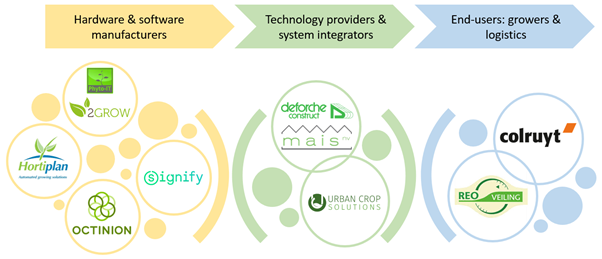Growing lettuce in a virtual world
(04-10-2021) Cross-talk is an innovative research project that will focus on the cultivation of lettuce as a model plant for the design of future-oriented vertical production systems.
The innovative cultivation of vegetables is evolving rapidly, the recent move towards multilayer cultivation (vertical farming) is part of this. Vertical farming allows crops to be grown on a smaller surface area, which means they can be brought closer to the consumer. To make optimal use of this new method of cultivation, knowledge of the dynamic interaction between plant and climate is crucial, in which yield and quality are paramount: how can light, temperature, relative humidity and CO2, as well as their spatial gradients, be used optimally to grow high-quality vegetables on a limited surface area?
The optimal use of space in the urban environment or in existing commercial greenhouses, coupled with improved control of quality characteristics, can become an interesting business model. However, important questions remain on how a dynamic climate during crop growth and development results in optimal crop production and quality. This is challenging due to the strong link and feedback between plant and climate. The goal of the Cross-talk project is to provide groundbreaking solutions. Cross-talk is an innovative FWO-SBO research project of Ghent University that falls within the scope of the Agrotopia chair. The project is being realised with financial support from FWO Flanders and a wide range of private players from the horticultural sector, ranging from hardware and software producers Phyto-IT, 2Grow, Signify, Octinion and Hortiplan to production system suppliers Deforche Construct, Maïs Automatisering and Urban Crop Solutions. End users Colruyt and Reo Veiling also support the project. This ensures that a wide range of expertise can be used within the project.
In vertical production systems, plants experience a drastically different microclimate compared to traditional greenhouse cultivation, where the structural design can be chosen entirely freely. Depending on the needs of the crop, it is possible to vary the height of the layers, the light colour and intensity of the lamps, but also, for example, the air flow, which plays an important role in both yield and quality. Moreover, a multi-layer system can be incorporated into a classic greenhouse system, creating a combination of daylight and artificial light that can be different for each layer. Such a large number of complex combinations cannot all be experimented with to find an answer to the question: "what is optimal?"
Therefore, Cross-talk will bundle the scientific knowledge in a 3D model in which plant and growing environment continuously interact. Through unique experiments, knowledge about plant growth is built up and biological underlying mechanisms are elucidated. We learn how and how much the plant can grow in direct response to its microclimate. By incorporating these dynamics in a 3D plant model, scientifically based predictions can be made about growth, production and quality of the crop, driven by climate. This makes the 3D plant model a valuable application to further optimise cultivation or to design innovative production systems. Thanks to the 3D aspect of our approach, light absorption, gas exchange (water vapour and CO2) and the impact of plant structure on air flow can be accurately quantified. This direct link and dynamic interaction between plant and environment is revolutionary, and is expected to become a trendsetter in the sector.
Cross-talk will focus on the cultivation of lettuce as a model plant for the design of future-oriented vertical production systems. Lettuce has the advantage of being compact and therefore ideal for multi-layer cultivation. The 3D plant model describes mathematically, in a virtual world, all the processes that take place in reality at leaf level. Since the lettuce leaf is also the end product, both yield and quality can be optimised. An example is the occurrence of tipburn. How exactly it occurs is not yet fully understood, but according to one theory it has to do with stagnant air in the crop, which prevents the plant from transpiring. The approach within Cross-talk will also allow a better understanding of such problems, and in time this will contribute to new knowledge within lettuce cultivation that can be immediately translated into practice.


